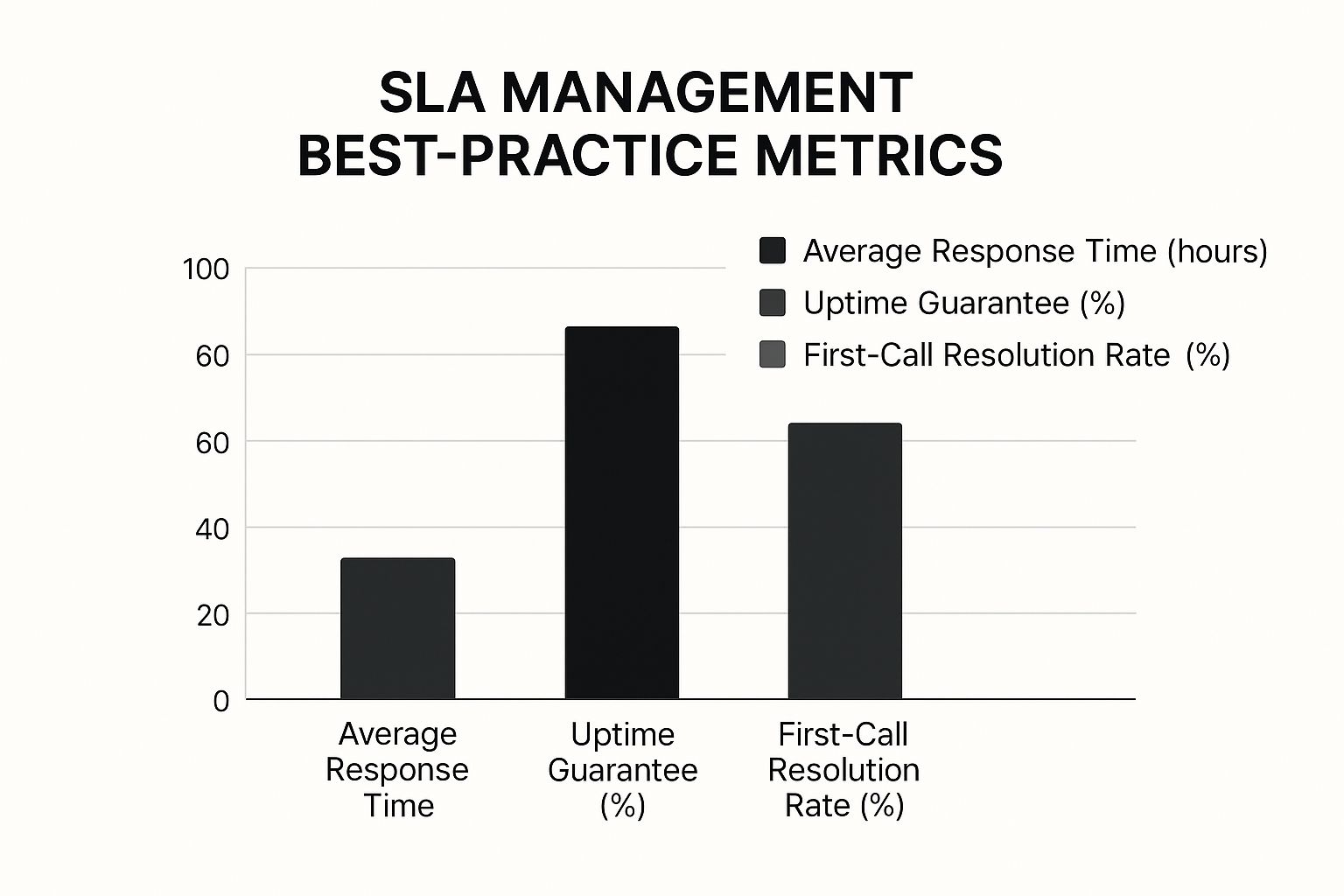A Service Level Agreement (SLA) is much more than just a piece of paper in a stack of contracts. It’s the official rulebook that governs the relationship between a service provider and a customer, turning vague promises into solid, measurable commitments.
Think of it this way: an SLA clearly defines the level of service everyone agrees on, laying out performance metrics, responsibilities, and what happens if things don't go according to plan.
Understanding The Service Level Agreement

At its heart, a service level agreement is all about accountability. It cuts through the fog of ambiguity, making sure everyone knows exactly what the customer should expect and what the provider is obligated to deliver. This isn't just about setting abstract goals; it's about forging a shared understanding that protects both sides and keeps the entire operation transparent.
Let's say you hire a managed service provider to handle your company's IT network. Without an SLA, you're left with fuzzy promises like "we offer fast support" or "we guarantee high uptime." What does that even mean?
An SLA gets rid of the guesswork by putting concrete numbers to those promises. For example:
- Guaranteed network uptime of 99.9% each month.
- A maximum response time of 15 minutes for any critical support tickets.
- Full resolution of non-critical issues within 24 hours.
This kind of detail ensures everyone is working from the same script. It prevents frustrating disputes down the road and sets clear expectations right from the start. It’s a cornerstone document among the many essential IT agreements and contracts that help businesses run without a hitch.
The Core Functions Of An SLA
A well-crafted SLA performs several key jobs that are fundamental to building a strong, transparent partnership. It’s not just a legal formality; it’s a living, practical tool for managing the entire service relationship. For those interested in how these agreements play out in a cloud-first world, resources on understanding Service Level Agreements in an AWS context offer a great deep dive.
At a high level, an SLA boils down to a few primary roles that keep the relationship on track.
Core Functions of a Service Level Agreement
| Function | Explanation |
|---|---|
| Defines Expectations | Spells out the exact services, performance standards, and quality levels to be delivered. |
| Establishes Metrics | Sets specific, measurable key performance indicators (KPIs) to monitor service quality objectively. |
| Outlines Responsibilities | Details the duties of both the service provider and the customer, leaving no room for confusion. |
| Specifies Remedies | Defines the penalties or service credits that apply if the agreed-upon service levels are missed. |
Ultimately, these functions work together to create a framework where both parties know the rules of the game and can work together effectively.
The Anatomy of an Effective SLA
A great Service Level Agreement isn't about vague promises. It’s a detailed blueprint for the entire service relationship, leaving no room for guesswork. Think of it like building a custom home: you wouldn't start with just a rough sketch. You'd need a comprehensive plan detailing every single room, material, and measurement.
This detailed structure makes sure everyone—both the provider and the customer—knows exactly what to expect. It lays out the roles, responsibilities, and performance standards, creating a partnership built on transparency and accountability from day one.
Foundational Components of a Strong SLA
Every solid SLA starts with a clear statement of agreement. This is the formal handshake. It identifies who is involved, the purpose of the agreement, what it covers, and the start and end dates.
Next, you need to spell out the services provided. This isn't the place for a high-level summary. It should be a granular list of every single service, whether it's network monitoring, data backups, or customer support. This clarity ensures there's no confusion down the road about what’s included and what’s not.
A well-defined SLA is the cornerstone of trust in any service-based partnership. It transforms assumptions into explicit commitments, creating a framework for accountability and mutual success. Without this clarity, both parties are navigating a complex relationship without a map.
Defining Performance and Responsibilities
The real meat of an SLA is in its performance metrics. These are the hard numbers that define what "good service" actually looks like. The most common metric is service availability, often seen as a percentage like 99.9% uptime. That isn't just a number; it translates into a tangible commitment—a maximum of about 43 minutes of downtime per month.
Other crucial metrics usually include:
- Response Time: How fast does the provider have to acknowledge a problem?
- Resolution Time: Once they’ve acknowledged it, how long do they have to fix it?
- Security Standards: What specific measures are in place to protect data and stop threats?
Just as important are the responsibilities of both parties. A good SLA clearly states who is responsible for what. It might specify that the provider handles all routine maintenance, while the client is responsible for reporting issues in a timely manner.
Planning for Contingencies and Evolution
Things change, and sometimes things go wrong. A smart SLA plans for this. That’s where disaster recovery protocols come in. The agreement should detail the exact steps for recovering from a major outage, including specific targets for recovery time (RTO) and how much data loss is acceptable (RPO).
Finally, any effective SLA needs a plan for its own lifecycle. A termination clause spells out the conditions under which either party can walk away from the agreement. A review schedule is also essential, setting up regular checkpoints to re-evaluate the terms and make sure the SLA still makes sense for everyone involved.
Putting together an airtight SLA can be complex, but modern tools can simplify the process. Technologies like AI for Service Level Agreements) can help you cover all your bases accurately and efficiently.
Why Your Business Depends on SLAs

A Service Level Agreement is so much more than a dense technical document. It’s a core part of your business strategy, acting as the handshake that solidifies your relationship with a service provider. Without it, you’re essentially operating on trust and assumptions—a risky position that can lead to service failures, unexpected downtime, and expensive arguments.
This formal agreement turns a simple vendor transaction into a genuine partnership grounded in transparency and mutual accountability. By spelling everything out from the start, you get rid of the guesswork. Both sides know exactly what’s expected, how success is measured, and what their responsibilities are. It’s this clarity that lets you manage risk effectively and build stable, predictable business relationships.
The market data backs this up. The global Service Level Agreement Tracking System market is expected to jump from USD 3.2 billion in 2025 to USD 15.3 billion by 2033. That explosive growth shows just how vital SLAs have become for businesses that need to protect their operations. You can dig deeper into the expanding SLA tracking market research to see the trends for yourself.
Fostering Trust Through Transparency
One of the best things an SLA does is encourage open and honest communication. When everything is written down—performance metrics, scope of work, penalties for failure—there’s no room for arguments based on feelings or vague recollections. The conversation is always rooted in hard data.
This creates a clear, agreed-upon process for fixing things when they go wrong. Instead of playing the blame game during a service outage, the SLA acts as a playbook for what happens next. This structured approach not only gets you back online faster but also prevents a crisis from poisoning the long-term partnership.
Think of an SLA as a pre-emptive conflict resolution tool. It sets the rules of engagement before the game even starts, so when a problem pops up, everyone’s focus is on the solution, not on assigning blame.
Averting Crisis with Clear Guidelines
Picture an e-commerce business gearing up for its biggest sales weekend of the year. A server crash at that moment would be a complete disaster, potentially costing them millions. Fortunately, they had a rock-solid SLA with their cloud hosting provider. It promised 99.99% uptime and, crucially, a four-hour maximum resolution time for any critical failures.
When an outage hit right in the middle of their peak season, they didn't have to scramble. The SLA kicked in automatically. The provider, legally bound by the terms, immediately assigned their best people to the problem. They restored service well within the four-hour window and, as agreed, issued service credits to compensate for the disruption.
The crisis was managed, sales were saved, and the partnership remained strong. All because a clear, well-defined SLA was there to guide everyone’s actions.
Choosing the Right Type of SLA
Not all SLAs are cut from the same cloth, and they shouldn't be. Think of it like buying a car. Sometimes you just need a reliable sedan that gets everyone from A to B—a standard, one-size-fits-all solution. Other times, you need a heavy-duty truck with a specific towing capacity and off-road capabilities for a specialized job.
The type of SLA you choose has to match the reality of the business relationship. This flexibility is what makes SLAs so powerful. Picking the right structure ensures that the performance promises and responsibilities line up perfectly with what you’re trying to achieve. There are three common models, each offering a different way to frame these commitments.
The Customer-Based SLA
A customer-based SLA is the bespoke suit of the agreement world. It’s custom-built from the ground up for a single client. This is the go-to model when a customer has very specific, non-standard needs that just don't apply to anyone else.
Imagine a large e-commerce giant that needs its cloud provider to guarantee exceptional performance and security specifically during Black Friday week. That would call for a customer-based SLA, covering all services provided to that one client under a single, highly customized contract that addresses their unique peak-season demands.
The point of a customer-based SLA is to deliver a white-glove service experience, defined entirely by the client's unique operational needs. It's an acknowledgment that for some businesses, off-the-shelf just won't do.
The Service-Based SLA
On the other end of the spectrum is the service-based SLA. This is a standardized agreement that applies to one specific service for all customers who buy it. It’s the most common approach for SaaS companies, hosting providers, or your local internet company. If you sign up, you get the same guarantees as everyone else.
A great example is a cloud storage provider that offers a service-based SLA guaranteeing 99.9% uptime and 24/7 customer support for all users on its business tier. This approach is incredibly efficient and scalable because it sets one clear, consistent performance standard for that service, no matter who the customer is.
The Multi-Level SLA
A multi-level SLA is a clever hybrid, blending elements of the other two models into a tiered structure. It’s perfect for large organizations trying to manage agreements internally without creating a mess of duplicated, conflicting contracts. This model neatly separates the agreement into different layers.
It usually breaks down like this:
- Corporate Level: This is the foundation. It covers the big-picture stuff that applies to every single person in the company, like basic security protocols or IT helpdesk hours.
- Customer Level: This middle layer gets more specific, addressing issues relevant to a particular department or user group. For example, it might outline unique requirements for the marketing team’s CRM software.
- Service Level: The most granular layer, this drills down into the specifics for one particular service, like the uptime guarantee for the accounting department's payroll system.
These different SLA flavors reflect the reality of modern business needs. The ability to choose between a customer-centric, service-specific, or layered approach is what makes them so adaptable. To see how these agreements fit into the wider world of business contracts, take a look at our guide on the most common IT contract types. Picking the right framework is the first step toward a clear, productive, and successful partnership.
Key Performance Metrics To Include In Your SLA
An SLA is only as strong as the metrics it's built on. Without clear, measurable targets, you're left with vague promises and a lot of room for misunderstanding. The right Key Performance Indicators (KPIs) are what give the agreement its teeth, turning it from a piece of paper into a practical tool for managing performance.
Think of these metrics as the official scorecard for your relationship with a service provider. They create a shared, objective definition of what "a good job" actually looks like. This way, you're not relying on gut feelings to gauge performance; you're looking at hard data.
Core Metrics For Service Accountability
While you can tailor an SLA to your specific needs, some metrics are just about universal. They show up time and again because they have a direct and immediate impact on your business operations and, ultimately, your customers.
- Service Availability (Uptime): This is the big one. It simply measures what percentage of the time a service is up and running. The difference between 99.9% and 99.99% uptime might sound tiny, but it's massive in practice. That 0.09% difference is the gap between nearly 44 minutes of downtime per month and just over 4 minutes.
- First-Call Resolution (FCR): A great indicator of a skilled support team. This tracks the percentage of support tickets or calls that get solved on the very first try, with no need for a follow-up or escalation to a senior tech. A high FCR means less frustration and faster fixes.
- Response and Resolution Times: People often mix these up, but they’re two separate things. Response time is how fast the provider acknowledges your reported issue. Resolution time is how long it takes them to actually fix it. You need both.
This visual helps put some common industry standards into perspective.

As you can see, the best agreements don't just promise high uptime; they pair it with lightning-fast response and resolution times to keep any potential disruption to an absolute minimum.
Common SLA Metrics and Industry Benchmarks
To get a clearer picture, it helps to see these metrics side-by-side with what's considered standard in the industry. This table breaks down some of the most essential KPIs you’ll encounter.
| Metric | What It Measures | Common Benchmark |
|---|---|---|
| Uptime/Availability | The percentage of time a system or service is operational and accessible. | 99.9% (Good) to 99.999% (Excellent) |
| Mean Time to Respond | The average time it takes for a provider to acknowledge a new support ticket. | < 1 hour for critical issues, < 24 hours for low priority |
| Mean Time to Resolve | The average time it takes to completely fix an issue after it has been reported. | < 4 hours for critical issues, < 2-3 days for non-critical |
| First-Call Resolution | The percentage of issues solved during the first interaction with support. | Industry average is around 70-75% |
| Error Rate | The percentage of operations that fail, such as a failed data backup or transaction. | Often < 0.1%, but highly dependent on the service |
These benchmarks give you a solid starting point for negotiations, ensuring the targets you set are both ambitious and achievable.
Security and Compliance Metrics
Beyond just keeping the lights on, your SLA needs to address how your provider protects your business. Security metrics are non-negotiable for safeguarding your data and ensuring you meet any regulatory requirements.
Here, you'll want to define clear expectations. This often includes system availability targets, typically between 99.5% and 99.9%, but also specific security response times. For example, a contract might state that a critical security incident must be acknowledged within one hour and fully resolved in under four hours.
An SLA without metrics is like a game without a scoreboard. You might be playing, but you have no idea who is winning or how to improve. Clear metrics ensure everyone knows the score at all times.
Setting these goals isn't something you do in a vacuum. It requires a real conversation with your provider to land on targets that work for everyone. By grounding your agreement in these kinds of concrete metrics, you create a foundation for a fair, transparent, and successful partnership. For a more detailed look at this, check out our guide on measuring performance in IT outsourcing contracts.
Frequently Asked Questions About SLAs

Even after you've got the basics down, some practical questions about service level agreements always pop up. Let's tackle some of the most common ones to give you the confidence to manage SLAs effectively.
What Happens When an SLA Is Breached?
When a service provider doesn't hit a target laid out in the SLA, that's a breach. It's not just a minor hiccup; a breach sets off a pre-planned chain of events meant to make things right for the client and push the provider to resolve the problem quickly.
The most common solution is issuing service credits. You can think of these as a partial refund for the service that didn't meet the promised standard. For instance, if your cloud provider guaranteed 99.9% uptime but only managed 99.5%, the SLA might state you get a 10% credit on that month's invoice.
For more serious or repeated failures, the consequences can be steeper:
- Financial Penalties: These are straight-up cash payments, usually reserved for major issues that cause significant disruption to your business.
- Contract Termination Rights: If breaches are severe or happen over and over, the SLA might give you the right to walk away from the contract without paying a penalty.
- Root Cause Analysis: The provider might be required to perform a full investigation, identify the core problem, and present a formal plan to make sure it never happens again.
The point isn't to be punitive. It’s about accountability. These remedies ensure the provider is held to their promises and that you are compensated fairly when they fall short.
Can You Change an SLA After It Is Signed?
Yes, and you absolutely should. A good service level agreement is never a "set it and forget it" document. The best ones are living agreements that adapt as your business and your needs evolve.
Think about it—the metric that was your top priority last year might be less critical today. Or maybe you've adopted a new technology that requires a completely different set of performance standards. This is precisely why well-crafted SLAs include a clause for regular reviews and updates.
An SLA is a snapshot in time. Regular reviews ensure that the agreement continues to accurately reflect the business relationship and provides genuine value to both the client and the provider. Sticking to an outdated SLA is like using an old map to navigate a new city.
These reviews are typically scheduled annually or semi-annually. It’s a chance for both parties to sit down, talk about what’s working and what’s not, and make necessary adjustments. Any changes are then formally documented in an addendum and signed by everyone, keeping the agreement relevant and powerful.
Who Actually Writes the SLA?
Crafting an SLA is a team sport, not a solo effort. While the service provider usually prepares the first draft—they're the experts on their own capabilities, after all—the final document should always be the product of collaboration. If a provider just slides a non-negotiable SLA across the table, consider it a major red flag.
The process has to be a partnership. The provider brings their technical knowledge, performance data, and an understanding of what's realistically achievable. You, the client, bring the most important part: a deep understanding of your business objectives, operational priorities, and what successful performance actually looks like from your perspective.
This back-and-forth negotiation is where the magic happens. It’s the time to align expectations and clear up any potential confusion before it can turn into a real problem down the road. By working together to define metrics, set targets, and agree on remedies, you create a final SLA that's fair, realistic, and sets the stage for a strong, long-lasting relationship.
At Clouddle, our managed technology solutions are built on a foundation of trust and transparency. We work collaboratively with you to build SLAs that align perfectly with your business goals, ensuring you get the performance and reliability you need to succeed. Discover how our integrated services can protect your assets and optimize your operations.


